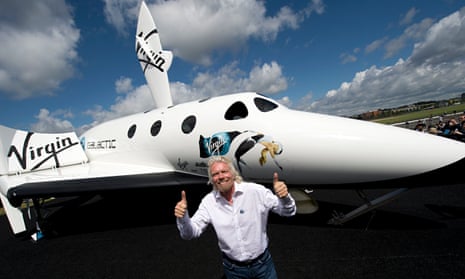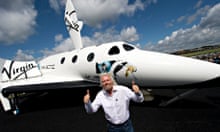George Whitesides, Nasa’s former chief of staff, holds up a model of a delicate white spacecraft. With the long narrow wings of a glider, it looks almost too fragile for its intended journey to the edge of earth’s atmosphere.
But this slender frame is carrying the dreams of 700 aspiring astronauts: private citizens who have paid up to $250,000 (£155,000) per head to Sir Richard Branson’s Virgin Galactic for the chance to take a trip to the stars. Now chief executive of Galactic, Whitesides’ mission is to turn the British entrepreneur’s vision of a commercial spaceline into reality.
“We are living through one of the greatest periods of innovation in aerospace since the dawn of the space age,” says the quietly spoken Bostonian. Whitesides is not a natural salesman, but he is passionate about his project. “The amount of new ideas that are coming up and the amount of new capital that is being infused is really exciting, and I really do believe that Virgin Galactic has the potential to be a world changing company.”
Galactic is headquartered in California’s Mojave desert, but we are in the London office, where the wall of the marketing suite is covered with an image of the earth seen from space. Whitesides is on a transatlantic mission to dispel growing doubts about whether Virgin Galactic will ever take off.
The project has been a decade in development and burned through $500m, and the completion date has moved so often that Private Eye magazine has begun keeping a record, under the headline: “Beam us up, Beardie!” The latest forecast is for early 2015: on David Letterman’s television show in September, Branson announced his family would be joining him for the first flight, in “February or March of next year”.
Has Whitesides been given a deadline? “No,” he replies. When will the SpaceShipTwo make its maiden voyage? “Soon.” The answer is understandably guarded. A year ago he told an interviewer the moment was so close he could “taste it”. Then a decision was taken in May of this year to change the fuel in the rocket motor, and a whole new round of tests began.
As a licensed private pilot, and founder of Yuri’s Night, a yearly celebration of the world’s first space flight, his interest is more than professional. In 2005, George and his wife, the astrobiologist Loretta Hidalgo Whitesides, were among the first to pay for seats on Branson’s spacecraft. The Whitesides were going to take their honeymoon in space.
They were married in the valley of the moon in California in 2006, but are still waiting to redeem their tickets. “We’ll still do our honeymoon, just a little bit later than planned,” he quips.
To date, the craft being developed under hangars in the Mojave desert has made only three rocket-powered test flights, all well short of its intended altitude. The model in Virgin’s London office, on the other hand, has certainly seen some use – one of its tail fins is missing and another is hanging by a thread.
Branson’s spacecraft is the brainchild of a engineer called Burt Rutan. With financing from Microsoft co-founder Paul Allen, he set out to win the Ansari X Prize for the first nongovernmental team to launch a reusable manned craft into space twice within two weeks.
His solution, which remains the model for Galactic, was to build a mothership that would carry the rocket to a high altitude. The rocket, SpaceShipOne, would then decouple and, at a safe distance, fire its own engine. The objective was to reach the Karman line, the notional boundary between earth’s atmosphere and space, some 100km (62 miles) above sea level, before dropping back down to earth.
With two flights successfully completed and the Ansari prize bagged, Branson decided to invest. His head of communications, Will Whitehorn, was put in charge of the project. A larger craft called SpaceShipTwo (SS2) would be built, capable of carrying six passengers and two pilots. At the time, Branson was predicting commercial launch by 2007, with several flights a week. But the work needed to make the craft safe enough for space tourists was considerable.
On two of the six powered flights SpaceShipOne had made before being hung in the Smithsonian museum, its pilot Mike Melvill experienced potentially life-threatening failures. And in 2007, with the project already behind schedule, an explosion during the testing killed three of Rutan’s engineers.
“We’ve changed dramatically as a company,” claims Whitesides. “When I joined in 2010 we were mostly a marketing organisation. Right now we can design, build, test and fly a rocket motor all by ourselves and all in Mojave, which I don’t think is done anywhere else on the planet.”
Under his lead – Whitehorn retired in 2011 - the Galactic has grown from 25 people to 425. Design and construction, once outsourced to Rutan’s company, are now managed in house and the team includes everyone from mechanics to ground control.
Branson’s boast is that Galactic could eventually replace the now defunct Concorde as the wealthy traveller’s supersonic airline, ferrying passengers not only to space but from London to Sydney in two hours instead of 22. Some $380m has poured in to Galactic from a state owned Abu Dhabi fund, Aabar Investments, which hopes to build a space port in the Middle East and now jointly owns the company with Branson.
Galactic has also collected $80m from ticket sales – the celebrity waiting list includes Brad Pitt and Angelina Jolie, Lady Gaga and Stephen Hawking. In March, the Winklevoss twins – the US internet entrepreneurs who once sued former Harvard classmate Mark Zuckerberg, claiming they helped create Facebook – helped push advance bookings past the 700 mark. The money has not been spent on developing SS2, says Whitesides, and anyone is entitled to a refund, for any reason.
“We have a terrific customer,” he says. “It is easy to be critical of hard big things from the sidelines but these are folk who have put their money where their mouth is. They want to achieve their dream and they view us as having the best chance of doing that.”
Among Virgin’s ticketholders is the West End star Sarah Brightman. But her first trip into space will not be with Galactic. She has paid a reported $52m for a seat on Russia’s Soyuz capsule plus a ten day sojourn on the international space station, and begins training in January.
While Galactic is grounded, other projects have taken off. SpaceX, the American startup run by Elon Musk, sent its Dragon capsule to the space station in 2012 and has been transporting cargo there ever since. Last month, along with Boeing, SpaceX signed a contract to develop a space taxi for Nasa.
But Whitesides remains confident. A final ground test of a new fuel should confirm within days that the craft now dubbed SS2.02 is ready to take to the sky.
Whitesides believes powered flights will resume this autumn, during which SS2 must show it can fire its engine for the required 60 seconds, cross the Karman line, and return to earth without catching fire as it re-enters the atmosphere. If all goes well, the Federal Aviation Administration should then issue Galactic with a commercial license, allowing it to carry paying customers.
Further test flights will be used to train pilots and ensure passengers can move around the cabin safely. Once SS2 reaches space, its engine will cut out and the citizen astronauts will experience four minutes of zero gravity. They will unclip their seatbelts and gaze down at the earth through portholes in the cabin ceiling as the craft makes an upside down arc, before returning to earth.
Of course, technical hitches could delay the project again, perhaps indefinitely. Does Virgin Galactic have a fallback plan? “No,” says Whitesides. “It’s going to happen, we are going to do it. It’s going to be great.”




Comments (…)
Sign in or create your Guardian account to join the discussion